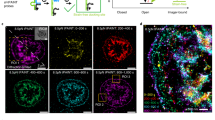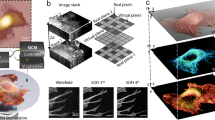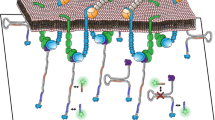Abstract
We demonstrate live-cell super-resolution imaging using photoactivated localization microscopy (PALM). The use of photon-tolerant cell lines in combination with the high resolution and molecular sensitivity of PALM permitted us to investigate the nanoscale dynamics within individual adhesion complexes (ACs) in living cells under physiological conditions for as long as 25 min, with half of the time spent collecting the PALM images at spatial resolutions down to ∼60 nm and frame rates as short as 25 s. We visualized the formation of ACs and measured the fractional gain and loss of individual paxillin molecules as each AC evolved. By allowing observation of a wide variety of nanoscale dynamics, live-cell PALM provides insights into molecular assembly during the initiation, maturation and dissolution of cellular processes.
This is a preview of subscription content, access via your institution
Access options
Subscribe to this journal
Receive 12 print issues and online access
$259.00 per year
only $21.58 per issue
Buy this article
- Purchase on Springer Link
- Instant access to full article PDF
Prices may be subject to local taxes which are calculated during checkout





Similar content being viewed by others
References
Lippincott-Schwartz, J. & Patterson, G.H. Development and use of fluorescent protein markers in living cells. Science 300, 87–91 (2003).
Stephens, D.J. & Allan, V.J. Light microscopy techniques for live cell imaging. Science 300, 82–86 (2003).
de Lange, F. et al. Cell biology beyond the diffraction limit: near-field scanning optical microscopy. J. Cell Sci. 114, 4153–4160 (2001).
Willig, K.I. et al. Nanoscale resolution in GFP-based microscopy. Nat. Methods 3, 721–723 (2006).
Betzig, E. et al. Imaging intracellular fluorescent proteins at nanometer resolution. Science 313, 1642–1645 (2006).
Lichtman, J.W. & Fraser, S.E. The neuronal naturalist: watching neurons in their native habitat. Nat. Neurosci. 4, 1215–1220 (2001).
Shannon, C.E. Communication in the presence of noise. Proc. Inst. Radio Eng. 37, 10–21 (1949).
Zamir, E. & Geiger, B. Molecular complexity and dynamics of cell-matrix adhesions. J. Cell Sci. 114, 3583–3590 (2001).
Wiedenmann, J. et al. EosFP, a fluorescent marker protein with UV-inducible green-to-red fluorescence conversion. Proc. Natl. Acad. Sci. USA 101, 15905–15910 (2004).
Zaidel-Bar, R., Itzkovitz, S., Ma'ayan, A., Iyengar, R. & Geiger, B. Functional atlas of the integrin adhesome. Nat. Cell Biol. 9, 858–867 (2007).
Smilenov, L.B., Mikhailov, A., Pelham, R.J., Jr., Marcantonio, E.E. & Gundersen, G.G. Focal adhesion motility revealed in stationary fibroblasts. Science 286, 1172–1174 (1999).
Shroff, H. et al. Dual-color superresolution imaging of genetically expressed probes within individual adhesion complexes. Proc. Natl. Acad. Sci. USA 104, 20308–20313 (2007).
Manley, S. et al. High-density mapping of single-molecule trajectories with photoactivated localization microscopy. Nat. Methods 5, 155–157 (2008).
Galbraith, C.G., Yamada, K.M. & Galbraith, J.A. Polymerizing actin fibers position integrins primed to probe for adhesion sites. Science 315, 992–995 (2007).
Hess, S.T. et al. Dynamic clustered distribution of hemagglutinin resolved at 40 nm in living cell membranes discriminates between raft theories. Proc. Natl. Acad. Sci. USA 104, 17370–17375 (2007).
Acknowledgements
We thank H. White for assistance with cell culture, M. Davidson (Florida State University) for the tdEos-paxillin plasmid and H. Peng (Janelia Farm Research Campus) for creating the simulation leading to Supplementary Fig. 5. This research was supported in part by the Intramural Research Programs of the US National Institutes of Health, the National Institute of Dental and Craniofacial Research, and the National Institute of Neurological Disorders and Stroke.
Author information
Authors and Affiliations
Corresponding author
Supplementary information
Supplementary Text and Figures
Supplementary Figures 1–6, Supplementary Tables 1–2, Supplementary Discussion, Supplementary Methods (PDF 2849 kb)
Supplementary Video 1
DIC images corresponding to the NIH 3T3 cell in Fig 2. DIC images were captured every 2 s and every other frame is displayed in the video. Cell displays continuous motion throughout the imaging period. (MOV 2272 kb)
Supplementary Video 2
Live cell PALM data for the NIH 3T3 cell in Fig. 2 parsed at three different intervals (15s, 30s, and 60s) to demonstrating the effect of temporal sampling rates on data resolution. Top panel consists of 20 image frames, each derived from 375 single-molecule frames. Center panel has 10 image frames each composed of 750 single-molecule frames, while bottom panel has 5 image frames, each composed of 1500 single-molecule frames. (MOV 1487 kb)
Supplementary Video 3
Complete PALM and Summed TIRF time series for the higher magnification view presented in Fig. 3. Eleven frames are shown, each composed of 1,000 single-molecule frames. (MOV 1897 kb)
Supplementary Video 4
Complete PALM series for the NIH 3T3 cell displayed in Fig. 4a. Eight PALM frames are shown, each composed of 625 single-molecule frames. (MOV 803 kb)
Supplementary Video 5
Complete PALM series for the CHO cell displayed in Fig. 4c. Four PALM frames are shown, each composed of 1250 single-molecule frames. (MOV 953 kb)
Supplementary Video 6
Complete PALM series for the NIH 3T3 cell displayed in Fig. 4e. Six PALM frames are shown, each composed of 1,250 single-molecule frames. (MOV 840 kb)
Supplementary Video 7
Complete PALM time series for the NIH 3T3 cell displayed in Fig. 5. Fourteen PALM frames are shown, each composed of 1,000 single-molecule frames. (MOV 1511 kb)
Supplementary Video 8
Higher magnification view of small focal adhesions from the NIH 3T3 cell in Fig. 5. Each frame is the sum of three consecutive PALM images, with the first PALM image pseudo colored red, the second green, and the third blue. This algorithm is repeated for successive frames with now the second PALM image colored red, the third green, and the forth blue. Eleven PALM frames are shown, each composed of 1,000 single-molecule frames. (MOV 535 kb)
Supplementary Video 9
Complete PALM series of a fixed CHO cell expressing tdEos/paxillin. Thirty-two PALM frames are shown, each composed of 1,000 single-molecule frames. Stochastic variations in molecular density are evident between adjacent frames, and the last 3 frames show a pronounced decrease in molecular density as all of the molecules are bleached. (MOV 1393 kb)
Rights and permissions
About this article
Cite this article
Shroff, H., Galbraith, C., Galbraith, J. et al. Live-cell photoactivated localization microscopy of nanoscale adhesion dynamics. Nat Methods 5, 417–423 (2008). https://doi.org/10.1038/nmeth.1202
Received:
Accepted:
Published:
Issue Date:
DOI: https://doi.org/10.1038/nmeth.1202
This article is cited by
-
Enhanced detection of fluorescence fluctuations for high-throughput super-resolution imaging
Nature Photonics (2023)
-
HOPE-SIM, a cryo-structured illumination fluorescence microscopy system for accurately targeted cryo-electron tomography
Communications Biology (2023)
-
Transmission structured illumination microscopy with tunable frequency illumination using tilt mirror assembly
Scientific Reports (2023)
-
An acoustofluidic scanning nanoscope using enhanced image stacking and processing
Microsystems & Nanoengineering (2022)
-
Optimal precision and accuracy in 4Pi-STORM using dynamic spline PSF models
Nature Methods (2022)



